Roku Setup
Roku devices have revolutionized our television experience, offering easy access to a huge selection of streaming services that cater to diverse preferences and interests. As a leader in the streaming device market, Roku provides an intuitive interface and a rich selection of options, from mainstream services like Netflix and Hulu to niche channels focusing on everything from fitness to foreign films.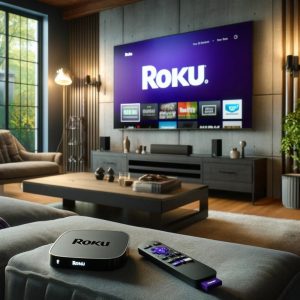
How to set up Roku correctly is essential to fully enjoy the spectrum of features and services it offers. Proper Roku setup can significantly enhance your streaming experience, assuring that you have access to high-quality content without disruptions. Whether you’re a tech novice or a seasoned enthusiast, understanding how to setup Roku efficiently is crucial.
The process of how do you set up Roku involves several key steps, from connecting your device to your TV to configuring settings that optimize performance and accessibility. Each step in the Roku setup is important, and skipping one could detract from your viewing experience. This guide will comprehensively take you through these steps, ensuring that your Roku is set up to provide the best possible entertainment experience in your home.
By ensuring that your Roku setup is done correctly, you not only gain access to a vast world of streaming but also ensure that your device performs optimally, providing you with a smooth and enjoyable viewing experience. Let’s dive into the essential steps and tips to get your Roku set up and running flawlessly, including how to set up a Roku on TV and Roku remote for the best usability. Whether you’re wondering how do you set up a Roku TV, this guide has you covered.
What You Need Before Starting Roku Setup
Before diving into the exciting world of streaming with your Roku device, it’s important to ensure you have everything needed for a seamless Roku setup. Preparing correctly can save you time and potential headaches, allowing you to enjoy your favorite shows and movies without delay.
Every Roku package typically comes with several key components:
-
Roku streaming player:
This is the main device that connects to your TV.
-
Remote control:
To navigate through Roku interface.
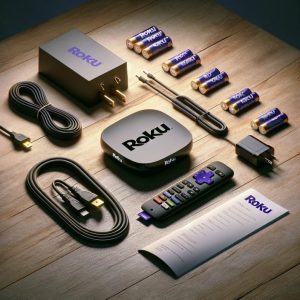
-
Power adapter:
To power your Roku player.
-
HDMI cable (not included with all models):
For connecting the Roku device to your television.
Ensure that these items are present as you unbox your Roku device. If your Roku model does not come with an HDMI cable, you need to buy it separately, as it is crucial for connecting the device to most modern televisions.
Additional Requirements for Roku Setup:
-
High-speed Internet connection:
Roku devices require a stable and fast internet to stream content without buffering. WiFi is typically used, though some models also offer a wired connection option.
-
HDMI cable:
As mentioned, if not included, you’ll need an HDMI cable to connect Roku device to your TV. This is essential for high-definition video and audio quality.
Setting Up a Roku Account:
Creating a Roku account is a critical step in the Roku setup process. Your Roku account stores information about the devices you own and allows you to manage your subscriptions and channels.
- Visit the official Roku website.
- Click on ‘Sign Up’ for creating new account.
- Provide email address, create a password, and complete the necessary information.
- Once account is created, you can link your Roku device to it during the setup process on your TV.
Understanding how to setup Roku starts with these preliminary steps. Whether you’re figuring out how do I set up Roku for the first time or you’re familiar with streaming device setups, having all the necessary components and access information at the start ensures a smooth installation. This preparation allows you to quickly move on to enjoying the vast array of streaming options Roku offers.
Roku Setup Step-by-Step Process
Setting up your Roku device involves a few critical steps that are essential to ensure you get the best streaming experience possible. From unboxing your device to linking it with your Roku account, each stage is important. Here’s a detailed guide to help you navigate the Roku setup process effectively.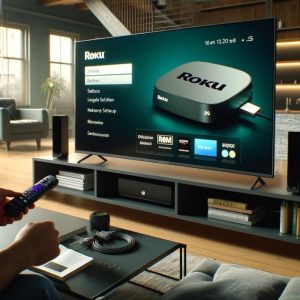
Unboxing and Connecting Your Roku Device
After unboxing your Roku device, the first step is to connect it to your TV and power source. Here’s how you can do it:
-
Connect to TV:
Use HDMI cable to connect your Roku device to your TV’s HDMI port. If you have a Roku Stick setup, plug it directly into the HDMI port.
-
Power Up:
Connect your Roku device to the power adapter and plug it into a power outlet. Some Roku models can also be powered via USB port on your TV.
-
Turn on Your TV:
Switch your TV to the correct HDMI input to see the Roku welcome screen.
This process varies slightly depending on model of Roku device, whether it’s a Roku Express setup or another model. Refer to a visual guide or video tutorial on the Roku website for model-specific instructions.
Initial Roku Setup
Once your device is connected, follow these steps to set it up:
-
On-screen Setup Guide:
Turn on your device and follow the on-screen setup guide. Choose your language, country, and allow the device to automatically detect display settings.
-
Connect to Wi-Fi:
Select your Wi-Fi network and enter the password. For a direct Roku WiFi setup, ensure you are inputting the correct credentials. If you encounter any issues like incorrect passwords or poor signal, troubleshoot accordingly by resetting your router or moving your Roku device closer to your Wi-Fi router.
-
Update Your Device:
Once connected to the internet, Roku device will check for updates and install them automatically. This ensures your device runs on the latest firmware, offering the best performance and newest features.
Linking Roku Device to Your Account
The final step in the setup process is to link your Roku device to your account:
-
Linking Process:
On your TV screen, you will see a code. Go to the Roku website on your computer or mobile and enter the code to link your device to your account.
-
Verify Your Account:
Always ensure that you’re on the official Roku website to avoid scams. This verification is crucial for protecting your personal and billing information.
-
Complete Setup:
Once your device is linked, you can start adding channels and personalizing your Roku homepage.
By following these detailed steps for a Roku setup, you ensure a smooth and secure start to using your device. Whether it’s understanding how to set up Roku on TV, ensuring you how to set up Roku without remote, these guidelines will help you get your device up and running with minimal fuss.
Configuring Roku Settings for Enhanced Experience
Once your Roku device is properly set up, the next step is to tailor its settings to enhance your viewing experience. This section will guide you through personalizing your Roku home screen and adjusting your display and audio settings to match your specific preferences and hardware setup.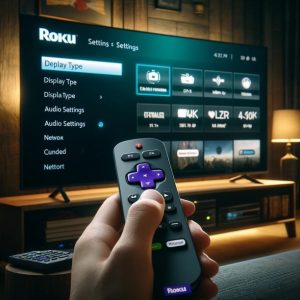
-
Adding and Removing Channels:
Navigate to the Roku Channel Store by selecting ‘Streaming Channels’ from the home menu. Here, you can browse, add, or remove channels. Add your favorite channels for quick access or remove the ones you no longer use to keep your interface clutter-free. This is a key part of the Roku setup that enhances your user experience by tailoring it to your viewing habits.
-
Customizing the Theme and Screensaver:
To change the theme of your Roku home screen, go to ‘Settings’ > ‘Theme.’ You can select from a variety of themes to change the look and feel of your interface. For screensavers, select ‘Screensaver’ under the same menu and choose one that you like or upload your own to personalize your device even further.
-
Optimizing Video Quality:
Go to ‘Settings’ > ‘Display type’ to adjust your Roku’s display settings. Roku will usually detect the best display settings automatically, but you can manually adjust them to match your TV’s resolution and aspect ratio, ensuring you get the best possible picture quality.
-
Guide to Syncing Roku with Sound Systems or Soundbars:
For the best audio experience, you may want to connect your Roku device to an external sound system or soundbar. Navigate to ‘Settings’ > ‘Audio’ and set it up to work with your external audio devices. Choose settings that match your specific sound system, whether it’s stereo or surround sound, to ensure the audio quality is optimized for your system.
Each of these settings is crucial for maximizing your Roku device’s performance and can be easily adjusted in your Roku setup. Remember to utilize the Roku remote control setup to navigate through these settings efficiently. By configuring both video and audio settings, you tailor the streaming experience to your preferences and equipment, ensuring that you enjoy high-quality content in the way that best suits your home entertainment environment.
Troubleshooting Common Roku Setup Issues
Even with a smooth initial setup, you may encounter some common issues with your Roku device. This section provides solutions to frequent problems related to setup, connectivity, and remote control issues, ensuring your streaming experience remains uninterrupted. Understanding how to solve these issues can save you time and enhance your overall Roku experience.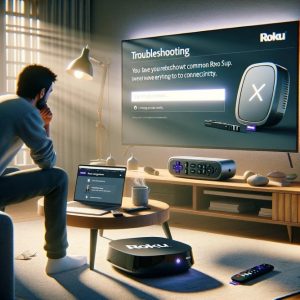
Solutions for Roku Connectivity Problems
-
Wi-Fi Connectivity Issues:
If your Roku device is having trouble connecting to the Wi-Fi, first ensure that your internet connection is stable. Restart your router and Roku device to refresh the connection. If problems persist, check the network settings on your Roku by going to ‘Settings’ > ‘Network’ > ‘Set up connection’ to re-establish a connection. To know more about Roku connectivity lssues, you can read our comprehensive blog on Roku Not Connecting to Internet.
-
Video and Audio Not Syncing:
Sometimes, after setting up Roku on TV, the audio and video may not sync properly. To resolve this, restart your Roku device or check for available updates that might address this issue. Adjust the audio timing under ‘Settings’ > ‘Audio’ if the problem continues.
-
Roku Device Not Recognizing HDMI Connection:
Make sure the HDMI wire is securely connected to both the Roku device and your TV. Try different HDMI port on your TV or replace the HDMI cable if you suspect it is faulty.
What to do if Roku Remote is Not Working
-
Remote Unresponsive:
First, try replacing the batteries in your remote. If it’s an IR remote, ensure there are no obstructions between the remote and the device. For enhanced or voice remotes, re-pair the remote to your Roku device by pressing the pairing button inside the battery compartment for three seconds.
-
Using Roku App as a Remote:
If your physical remote is lost or broken, you can set up Roku without a remote by using the Roku app available for iOS and Smartphones. This app turns your smartphone into a Roku remote and offers additional functionalities like voice control and private listening. If your Roku remote still isn’t working, you can read our blog post on Roku Remote Not Working.
How to Reset Roku Device
-
Soft Reset:
For minor glitches, you can perform a soft reset by going to ‘Settings’ > ‘System’ > ‘System restart’. This can solve issues without losing your settings or data.
-
Factory Reset:
If problems continue or you’re preparing to sell your device, a factory reset may be necessary. This can be done by navigating to ‘Settings’ > ‘System’ > ‘Advanced system settings’ > ‘Factory reset’. Remember that this will remove all your personal settings and remove all channels from the device.
By following these troubleshooting tips, you can quickly resolve common issues encountered during and after setting up Roku on TV.
FAQs
Q. How do I set up Roku for the first time?
- A: To know how do you set up Roku, start by connecting your Roku device to your TV and power source, then follow the on-screen instructions to connect to the internet and activate your Roku account.
Q. What are the steps to how to setup Roku on my smart TV?
- A: How to setup Roku involves connecting your Roku device to your TV via HDMI, powering on the device, and following the on-screen setup guide to connect to Wi-Fi and your Roku account.
Q. Can you explain how to set up Roku remote for controlling my device?
- A: How to set up Roku remote involves inserting batteries into the remote, pairing it with your Roku device by following the on-screen instructions, and using it to navigate and control your Roku.
Q. What is involved in setting up Roku on TV?
- A: Setting up Roku on TV requires you to connect your Roku streaming device to HDMI port of your TV, connect it to a power source, and complete the on-screen setup, including Wi-Fi connection.
Q. How do you set up a Roku TV right out of the box?
- A: To how do you set up a Roku TV, connect your Roku TV to a power source, switch it on, connect it to your internet via Wi-Fi, and follow the on-screen instructions to complete the setup.
Q. What should I do for Roku TV setup without a remote?
- A: For Roku TV setup without a remote, you can use the Roku mobile app as a remote control to connect your Roku TV to Wi-Fi and complete the setup process.
Q. How can I perform a direct Roku wifi setup on my device?
- A: To perform a direct Roku wifi setup, select ‘Network’ from the Roku settings menu, choose ‘Set up connection’, and follow the instructions to connect directly to your home Wi-Fi network.
Q. What is the process for setting up Roku without remote access?
- A: If you need to start setting up Roku without remote, you can use the Roku mobile app to control your Roku device and complete all setup steps via your smartphone.
Q. How do you configure Roku remote control setup for enhanced usage?
- A: Roku remote control setup includes programming your Roku remote to manage your TV’s power and volume by following the on-screen guide under ‘Remote’ settings in your Roku’s system preferences.
Q. What are the instructions for how to set up a new Roku remote with an older Roku model?
- A: To know how to set up a new Roku remote with an older Roku model, ensure the remote is compatible, then pair it by pointing it at the device and pressing the pairing button inside the battery compartment. Follow any additional on-screen instructions to complete pairing process.
Conclusion
By following detailed steps provided in this guide, you should now be enjoying a seamless streaming experience on your TV. Whether you were setting up a new device or troubleshooting an existing setup, the tips and insights shared should help enhance your viewing pleasure and make the most out of your Roku.
You’ve learned how to connect your Roku device to your TV, personalize your home screen, optimize audio and video settings, and troubleshoot common issues. This guide has covered everything from the initial Roku TV setup to advanced settings that can help you tap into even more features of your Roku device.
Proper setup is crucial for ensuring that your device functions efficiently, providing you with access to a vast array of streaming content without interruption. Knowing how to setup Roku, including the nuances of setting up Roku on TV and configuring it for the best performance, guarantees a superior streaming experience.
Should you encounter any further issues or if you have questions in the future about how to set up my Roku TV or how to maximize its capabilities, remember this guide is here to help. Roku is continually updating and improving its system, so staying informed about new updates and features can greatly enhance your streaming experience.
We hope this guide has been helpful in setting up your Roku on TV and that you are now better equipped to enjoy all the entertainment Roku has to offer.
To know more about Roku Setup and resolve its related issues, visit Roku Support Page.


Carol Miller
When setting up my Roku for the first time, what are the crucial steps I should follow to ensure it’s done correctly?
Support Admin
To set up Roku successfully when you first unbox it, begin by connecting the Roku streaming player to your TV using an HDMI cable. Power your Roku device by connecting it to an outlet with the provided power adapter. Turn on your TV and switch to the HDMI input that corresponds to where your Roku is connected; you should see the Roku welcome screen appear. Using the Roku remote, proceed with the on-screen prompts to choose your preferred language and connect to your Wi-Fi network. This connection is crucial for streaming, so ensure the Wi-Fi details are entered accurately. Once connected, your Roku will automatically search for and install any available updates, optimizing your device with the latest firmware. The final step in the Roku setup involves linking your device to your Roku account. You’ll need to enter a unique code shown on your TV into the Roku website to complete this process. By following these steps, your Roku will be ready to stream your favorite content seamlessly.
Nancy lopez
Can you explain how to setup Roku on my smart TV to maximize the device’s streaming capabilities?
Support Admin
To setup Roku on your smart TV effectively, start by ensuring your Roku device is connected to your TV’s HDMI port. Next, connect the Roku to a power source. Once everything is plugged in, turn on your TV and select the HDMI input to which the Roku is connected. You’ll be greeted by the Roku setup screen. Use the Roku remote to navigate the setup menus, starting with selecting your language. The next crucial step is to setup your Roku to connect to Wi-Fi; this ensures that you have access to streaming services and updates. Enter your Wi-Fi details carefully to avoid any connectivity issues. Your Roku will then check for any system updates and install them automatically. The final step involves linking your Roku device to your Roku account by following the instructions displayed on your TV, completing the Roku setup process. This setup ensures you can immediately start enjoying a wide range of streaming options available through Roku.